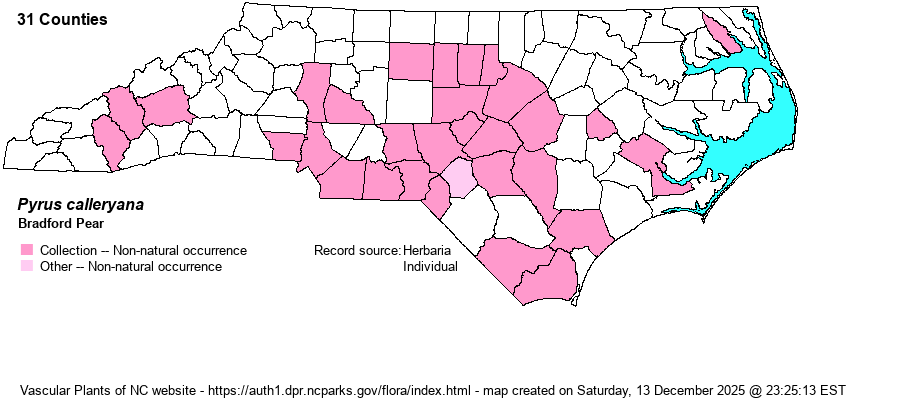| Author | Decaisne | |
| Distribution | Across the southern and central portions of the state; to date absent from most of the northern counties. No doubt occurs in other counties, not yet collected there but likely will in upcoming years.
Native of eastern and southeastern Asia; in N.A. NJ to MI and KS, south to FL and TX; CA. | |
| Abundance | Frequent to locally very common, rapidly becoming abundant in the central portions of the state. Cultivation in NC began in the 1970s (1960s?), with the first report of escapes in 1984 in Orange County. Rapidly expanding the range since 2000. Bradford Pear is glorious in flower and in fall color, but fertile cultivars are now invading and will be difficult to control. For a fascinating account of its spread, see Vincent (2005). | |
| Habitat | Moist to mesic soil of woodland borders, fields, roadside thickets, fencerows, bottomlands, yard weed. For the most part, it has stayed away from forest interiors, but it can occur in openings. | |
| Phenology | Flowering February-April; fruiting August-October. | |
| Identification | Bradford Pear is a small to medium tree with an elliptical, full crown. Leaves are broadly ovate to rotund, glabrous, shiny above, with a short drip-tip. Flowers grow from short shoots in umbel-like clusters, each flower up to an inch wide, white. The short shoots produce a sharp, straight thorn at the tip, these especially noxious in saplings. The species is apparently numerous enough and fragrant enough that the flowers are greatly attracting bees and other pollinators of white-flowered rose-family species such that flowers of native species such as hawthorns (Crataegus) and shadbushes/serviceberries (Amelanchier) are showing a reduced amount of pollination (and thus reproduction). Experts have noticed declines in such native species, believed to be blamable mostly on the recent and rapid spread of Bradford Pear trees. | |
| Taxonomic Comments | | |
| Other Common Name(s) | | |
| State Rank | SE | |
| Global Rank | GNR | |
| State Status | | |
| US Status | | |
| USACE-agcp | | |
| USACE-emp | | |

